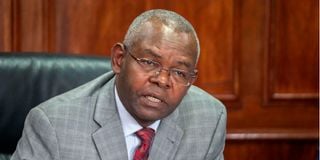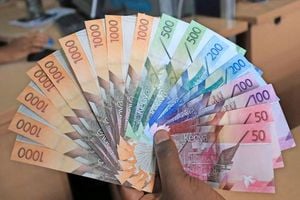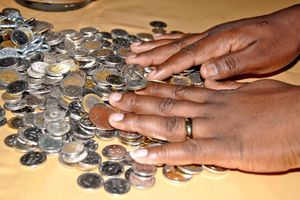
Central Bank of Kenya Governor Kamau Thugge.
The government has maintained a veil of secrecy around a new banknotes printing deal awarded to a German firm, extending a web of mystery that has masked multibillion-shilling money-printing tenders that have cost taxpayers over the years.
Central Bank of Kenya (CBK) last week announced changes to banknotes affecting five denominations with the new currency set to be in circulation “in the coming months.”
Governor Kamau Thugge avoided questions regarding the contract during a Monetary Policy Committee (MPC) meeting last Wednesday, only saying it was a German firm that is “one of the best.”
The governor did not respond to Nation’s questions last Thursday seeking the name of the German firm, the value of the contract, whether there was a competitive process to select the company and in the event the tender was single-sourced, the justification for direct procurement.
New changes
New changes like the signatures of the Governor, Dr Thugge, and the Principal Secretary, National Treasury, Dr Chris Kiptoo, the year of print – 2024, as well as new security features have necessitated fresh Sh50, Sh100, Sh200, Sh500 and Sh1,000 banknotes, according to CBK.
However, the CBK’s failure to make full disclosure about the latest venture raises eyebrows considering similar secrecy has shrouded previous money tenders that ended up costing taxpayers billions of shillings.
Following a parliamentary investigation into one such controversial deal, a Treasury minister and CBK governor were criticised for the loss of taxpayers funds and declared unfit to hold public office.
The mystery German firm has been awarded the tender just months after De La Rue, a British company that has supplied Kenyan currencies since independence, closed its Kenyan operations last year.
While the change comes just five years after the government introduced the notes currently in use, it is also raising eyebrows owing to the opaque nature of previous money-printing tenders, which imploded into scandal.
Already, some are raising a red flag about the latest deal.
“CBK has contracted a German firm to undertake the printing and make changes to the current denomination of the Kenyan currency without a satisfactory explanation. Scandal loading!” Lawyer and politician Ekuru Aukot said on Wednesday.
The currency-printing tender dramas started in 2003 when then President Mwai Kibaki administration exposed how his predecessor- Daniel Moi’s regime- had subjected Kenyan to a monopoly of currency printing through 10-year contracts with British firm, De La Rue Currency and Security Print Limited.
In December, 2002, days to the presidential election in which Moi’s preferred successor Uhuru Kenyatta was defeated by the opposition candidate, Mr Kibaki, the 10-year contract between CBK and De La Rue had expired and the bank hastily renewed the contract for another 10 years without any competitive tendering process.
In 2003, when the Kibaki administration took over power, this contract was cancelled by the bank on orders from the then Minister for Finance, David Mwiraria, who called for a competitive procurement process.
De La Rue had bagged the 10-year contracts since independence before the attempt by the outgoing Kanu government to renew the one signed in 1992 that had expired in December 2002.
But the Narc government soon authored its own scandal by avoiding competitive bidding.
From 2003 to 2006, when a new contract was signed, an investigation by a parliamentary watchdog exposed how taxpayers lost Sh1.8 billion in expensive interim money-printing deals.
“Since 2003, Central Bank had been procuring banknotes from De La Rue on interim orders without subjecting them to a competitive procurement process, contrary to government procurement regulations and procedures,” the National Assembly’s Public Accounts Committee (PAC) stated in a report following an investigation in 2012.
These short-term deals would prove costlier by Sh1.8 billion compared to the new contract that was later signed in 2006.
In May 2006, following a competitive procurement process, De La Rue was awarded another deal for the printing of 1.71 billion pieces of banknotes at a cost of Sh3.75 billion.
Prior to this award, CBK had procured from De La Rue Company four interim orders of current generation banknotes totaling l, 487,050,000 at a cost Sh5,584,940,934, which meant taxpayers paid Sh1.8 billion more in these expensive short term contracts compared to the Sh3.75 billion that would have been incurred.
Still, this cheaper 2006 contract for printing new generation banknotes was also in November, 2007, cancelled by the bank on a directive from Mr Amos Kimunya, the Minister for Finance at the time, on grounds that the government intended to enter into a joint venture with De La Rue Company.
Mr Kimunya had been appointed Finance minister on February 14, 2006, following the resignation of Mr David Mwiraria, who quit to pave way for investigation into the Anglo Leasing scandal.
Over the years as the government and De La Rue engaged in tender dramas, PAC revealed, the Central Bank resorted to procuring banknotes from the company at a cost almost double through these interim orders.
The committee found that De La Rue took advantage of the loopholes to overcharge CBK for the services. The MPs concluded that then Finance Minister, Mr Kimunya, and then CBK Governor Njuguna Ndung’u (he is also the immediate former Treasury CS) were responsible for the loss of Sh1.8 billion.
“The Ethics and Anti-Corruption Commission should investigate them with a view to taking appropriate legal action against them and recovering lost funds,” the PAC report stated.
When they appeared before PAC, Mr Kimunya- who was Finance minister from 2006 to July 2008- and Prof Ndung’u- who served as CBK governor from March 2007 until March 2015- defended their actions, saying they had done no wrong.
Mr Kimunya, who testified before the committee on April 17, 2012, as Transport minister, said when he joined Treasury in 2006, he was briefed by the then CBK Governor Dr Andrew Mulei and his deputy Mrs Jacinta Mwatela, the Permanent Secretary, Ministry of Finance and two others that the bank was changing currency designs.
Mr Kimunya also explained although De La Rue had received a 50 percent or USD25 million down payment for the deal to print 1 .71 billion pieces of bank notes, it planned to close down its Ruaraka plant.
The firm wanted assurances on guaranteed Kenyan government business or else it would relocate its operations to Malta where it could save on costs. According to Mr Kimunya, this was the basis for negotiations on a joint venture with the Kenyan government and his subsequent directive to CBK to cancel the contract with De La Rue.
Prof Ndung’u, who testified before the committee three times on April 28th and 29th and May 16, 2012, told MPs after the cancellation of the 2003 tender, CBK floated an open tender in January 2005 for the printing of 1.71 billion pieces of bank notes.
But to ensure a sustained supply of banknotes when the lengthy tender process was in progress, CBK entered into a 21-month contract with De La Rue Company for delivery of 820 million pieces of different denominations, Prof Ndung’u had disclosed.
The tender for 1.71 pieces attracted five bidders The firms were Giesecke & Devrient (Germany), De La Rue Currency (United Kingdom), Orell Fussli (Switzerland), Francois Chades Oberthur Fiduciaire (France) and Job Enschede Banknotes (Holland).
However, the entire tender was cancelled on June 6, 2005, due to various anomalies and a fresh tendering was required, Prof Ndung’u added.
“The cancellation and the expected lengthy retendering process necessitated an interim order for additional banknotes to forestall imminent stock-out gaps,” Prof Ndung’u told MPs.
Consequently, CBK placed an order for an additional 300 million pieces of existing banknotes from De La Rue at a price of,703,280 sterling pounds.
After fresh tendering, De La Rue bagged a new contract on May 4, 2006 for printing 1.71 billion pieces of new generation Kenya banknotes at a total cost of $ 51,195,840.
The only other firm to get to the final stage of the tender, Prof Ndung’u said, was Giesecke & Devrient GMBH of Germany, which quoted $.76,331,500
After Mr Kinunya ordered the cancellation of this contract in November, 2007, CBK again resorted to interim orders.
To meet the demand for currency, CBK placed an order for 390 million pieces of banknotes to cover the currency needs for two years at a cost of 10,521,569 sterling pounds. From the bank's projections, the 390 million pieces of banknotes in addition to stocks held as at September 2007 were expected to last up to October 1, 2009, Prof Ndung’u explained. “lt was then hoped that the joint venture negotiations would have been finalized,” he told MPs.
While the joint venture negotiations were ongoing, the bank once again placed an order for additional currency of 450 million pieces of banknotes on June 17 2009 at a cost of 13,138,360 sterling pounds to meet the country's currency needs until September, 2010.
ln July 2010, the bank again entered into another stop gap agreement with De La Rue for 483 million pieces of banknotes at a cost of 14,358,650 sterling pounds. “This order was meant to cushion the country's currency needs up to December, 2011, pending the completion of the joint venture agreement between the Government of Kenya and De La Rue,” Prof Ndung’u added.
Until closure of its operations in the country last year, De La Rue, held a 60 percent stake in its currency-printing factory in Ruaraka, Nairobi, while the government had a 40 percent stake.
Treasury had initiated the deal to acquire the stake in De La Rue’s Kenyan operations in secrecy, an action MPs later faulted and noted that it made the move when “the machines and technology used at the Ruaraka plant are analogue when modern technology is digital.”
The PAC investigation was triggered by a question in Parliament on November 2, 2011, by then lkolomani MP Boni Khalwale who asked the Deputy Prime Minister and Minister for Finance Uhuru Kenyatta to confirm whether De La Rue had been awarded a 10-year monopoly for printing Kenyan currency notes without being subjected to competitive international tendering.
Mr Kenyatta, who had been named Finance minister in January 2009, responded no new contract had been issued to De La Rue but disclosed negotiations were however ongoing for the acquisition of a stake in De La Rue’s Nairobi plant by the Kenyan government following approval by the Cabinet.
But this disclosure prompted further questions including from then Gwassi MP John Mbadi (now newly appointed Treasury cabinet secretary) who questioned why the government was investing in De La Rue without carrying out a feasibility study to establish its viability and profitability.
“During debate, Mwiraria and Kimunya, former Ministers for Finance, were mentioned in connection with cancellation of currency printing contracts between Central Bank and De La Rue. Prof. Ndung'u the incumbent Governor of Central Bank was also mentioned,” the PAC report noted.
Following the barrage of questions, Mr Kenyatta requested that the matter be referred to the PAC for further investigations.
Genesis of currency printing controversy and key players from 2003 to date
CBK Governor Kamau Thugge
Won’t disclose name of the German firm awarded new tender, contract price and process of procurement
From 2012 parliamentary investigation
Gwassi MP John Mbadi (now newly appointed Treasury cabinet secretary)
Questioned why the government was investing in De La Rue without carrying out a feasibility study to establish its viability and profitability.
Mr Uhuru Kenyatta (Deputy Prime Minister and Finance Minister who later rose to president)
Requested that the controversy over De La Rue deals with Kenyan government be referred to the Public Accounts Committee for further investigations.
Mr Amos Kimunya (former Finance minister) and Prof Njuguna Ndung’u (then CBK governor who is immediate former Treasury Cabinet Secretary)
Found responsible by PAC for the loss of Sh1.8 billion and the watchdog directed they be held accountable










